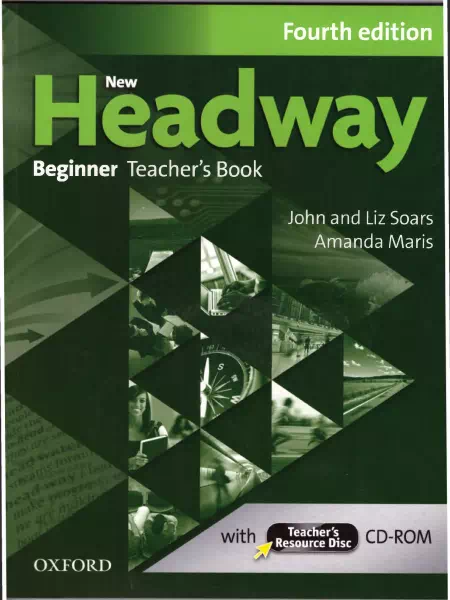New Headway Beginner Teacher’s Book 4th edition PDF download

New Headway Beginner Teacher’s Book 4th edition PDF
Reading At the beginning of the course, the reading material is tightly controlled and graded, ensuring that students encounter only one or two unfamiliar words. As the course advances, readings become longer and contain slightly more new vocabulary. This helps students practice handling unfamiliar words and prepares them for longer texts at the Elementary level.
Speaking In the presentation sections, students practice the pronunciation and intonation of new language. The practice sections include less controlled exercises that lead to freer speaking practice. Many speaking exercises are based on listening and reading activities, including regular role-plays. Speaking opportunities are provided before a text to introduce the topic and create interest, and after a text, often in the form of discussions.
Writing Writing exercises are generally small in scope. Students might write about their best friend, a postcard, a short description of a town they know, or a holiday description.
Everyday English This crucial part of the New Headway Beginner, Fourth Edition syllabus includes language input and practice in:
- Survival skills: numbers, dates, the alphabet, prices, recognizing signs, and asking for directions.
- Social skills: social expressions and greetings.
- Functional areas: making requests, shopping, and expressing feelings.
In these sections, there is sometimes an element of ‘phrasebook language.’ For example, in Unit 7, “Can I…?” is introduced in various situations without deep analysis of the grammar of “can” as a modal verb. The goal is for students to understand how to use the phrase politely to get what they want.
Grammar Reference Located at the back of the Student’s Book, this section is intended for home use, serving as a revision or reference tool.
Revision The new iTutor disc that accompanies the Student’s Book allows students to review and revise the content through interactive exercises. Additionally, there is a photocopiable activity for each of the 14 units at the back of the Teacher’s Book, also featured on the Teacher’s Resource Disc (TRD), along with 14 additional photocopiable activities. The TRD also includes 14 Unit tests, 14 Skills tests, four Stop and check tests, three Progress tests, and an Exit test.
Workbook The Workbook revisits and practices all language input (grammatical, lexical, and functional). It now comes with the iChecker disc, allowing students to test themselves throughout the course. The disc includes Writing Support activities and worksheets, pronunciation, and listening exercises, including listen-and-repeat exercises and unseen listening activities, which are especially beneficial for students lacking confidence in speaking or having listening/pronunciation issues. Students can refer to the tapescripts on Workbook page 88.
Teacher’s Book with Teacher’s Resource Disc The Teacher’s Resource Disc inside the back cover of the Teacher’s Book contains additional printable material to support the course. It includes customizable versions of all 28 photocopiable worksheets, with tips on modifications to make activities more applicable to students. The Disc also includes all testing materials (Unit tests, Stop and check tests, Progress tests, Exit test, and Skills tests with audio files) and the Student’s Book reference materials (Tapescripts, Word list, and Grammar Reference with related exercises).
Other Materials for New Headway Beginner
Video New video clips and classroom worksheets are available on the new Headway Beginner Fourth Edition iTools. There are 14 clips, one for each unit, with language and themes linked to the Student’s Book units. Students can access the videos on their iTutor disc. Most clips follow a documentary style and include native speaker interviews.
Teacher’s Resource Book This contains photocopiable games and activities to supplement the New Headway Beginner syllabus.
Conclusion The primary criterion for selecting every activity in New Headway Beginner, Fourth Edition is its usefulness for the survival of a low-level student in an English-speaking environment. The aim is to lay the foundations for a successful and enjoyable language-learning journey.
Contents
- Teacher’s Book
Format:PDF
Size: 5.99 MB
Pages:151
Series:New Headway
Level:Beginner
Edition:Fourth Edition
Date:2011
DOWNLOAD
Please register to view the hidden Download Links
Please register to view the hidden Download Links
Please register to view the hidden Download Links
Related Content
Headway Beginner Workbook 5th edition